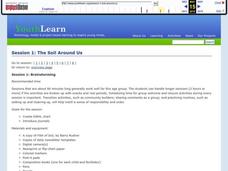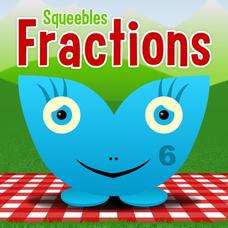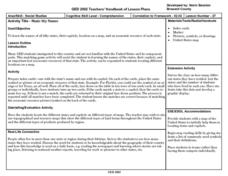Curated OER
Exploring Arizona's Biotic Communities Lesson 4: Which Team Are You On?
Who is not drawn to trading cards? In this lesson, junior ecologists create a trading card of an animal or plant from one of Arizona's biotic communities. Gorgeous sample cards are provided in the lesson plan as well as a plethora of...
Curated OER
D'Nealian Bingo
In this letter matching game worksheet, students cut apart and use 6 Bingo cards that will be used in a game of matching upper and lower case letters. Students match the lower case letters on the 16 call cards to the upper case letters...
Curated OER
Homophones
Here is a terrific lesson on teaching homophones to your upper graders! In it, homophone word cards and homophone bingo cards, which are embedded in the lesson, are used in a game format which reinforces this important part of speech....
Curated OER
Cause and Effect
Students examine the concept of cause and effect. They participate in a class discussion, play matching games, and play a memory/concentration game with cause and effect as the focus. Students complete an evaluation chart as an...
Little Book Lane
"Ch" Words
What do chug and chain have in common? The consonant digraph ch of course. Hold onto your hats – here is a packet of worksheets with enough practice activities to fill a short unit. It contains two lists of ch words, three practice...
Waterloo Mathematics
Grade 7 Patterning and Algebra: Algebraic Expressions
Classmates solve 18 different problems that are mostly word problems that apply algebraic expressions. They draw different combinations of masses on a scale that would balance. They also simplify expressions and solve for x in a number...
Curated OER
Breaking News: English Athlete's Hairstyles
Practice vocabulary and speaking skills in this ESL reading comprehension instructional activity. Middle and high schoolers participate in a number of before, during, and after reading activities based on an article entitled "Footballer...
Little Book Lane
"Sh" Words
Sh, sh, sh! When two letters together always make the same sound, they're called a consonant digraph. Get those early readers ready to use the sh sound with confidence. This packet contains printable wall cards, a...
Virginia Department of Education
Exploring 3-D Geometry
Take young mathematicians on an exploration of the world of 3-D geometry with this seven-lesson unit. After first defining the terms perimeter, area, and volume and how they apply to the real world, students continue on...
Curated OER
"The Soil Around Us" Project
Young geographers collect samples of different kinds of soil to match to the soil terms in Barry Rudner's rhyming book Filet of Soil: dirt, mud, dust, soot, etc. They start a glossary for the project on index cards or large sheets...
K-5 Math Teaching Resources
Base Ten Cards (tens and ones)
Strengthen your class's understanding of place value with this series of base-ten flash cards. Including illustrations representing a variety of numbers from 13 to 94, this resource can be used in many different ways...
Curated OER
Parent Functions Review Sheet
No laundry or cooking dinner here: these parent functions are all about math. Every graph you could think of from basic linear functions to the hyperbolic arccotangent function are included. With 40 parent functions, the worksheet...
Ontrack Media
Chart of Parent Functions
The characteristics of parent function vary from graph to graph. Let learners decipher the graph, table of values, equations, and any characteristics of those function families to use as a guide. The nicely organized page...
Curated OER
Spicy Hot Colors
First graders discover the importance of primary colors by reading a book in class. In this art lesson, 1st graders read the book Spicy Hot Colors, and discuss the three primary colors and the numerous combinations they can make....
Curated OER
A Bugs Life: Diary of an Insect's Metamorphosis
Students play games to learn about the life stages and metamorphosis of different insects. In this insects lesson plan, students discuss the life of insects, and then play matching, vocabulary, and memory games.
Curated OER
Frankenstein Opposites Cards
In this opposites worksheet, students color and cut apart 24 cards that are opposite pairs. Students then use the cards to match up the antonym pairs. There is a Frankenstein picture on each card.
Super Duper Publications
WH Question Cards - Pro: Who, What, When, Where, Why
Do you have kids on your caseload with wh questions goals, that need extra practice comprehending and asking who, what, when, where, and why questions? Then this clever app is designed for you!
Savvas Learning
Gerunds and Infinitives
Gerunds and infinitives are the focus of this 24-page grammar packet designed to give language learners opportunities to practice using these parts of speech. Included are exercises, activities, games, and assessments.
Key Stage Fun
Squeebles Fractions
We are not exactly sure what a Squeeble is, but apparently they love cake and fractions, and your little bakers-turned-mathematicians will also. This app focuses on the basics of fractions including modeling fractions, equivalent...
Curated OER
Word Families Accuracy
First graders work to build word family accuracy. In this word family lesson, 1st graders practice matching words with the same rime to words that they know. They play a matching game using words with the same rimes.
Curated OER
Word families accuracy
First graders read new words that share the same rime as a word they already know. In this word families lesson, 1st graders read words on index cards with the teacher, play a matching game with different rimes, and eventually read...
Curated OER
Beef
Addressing the intermediate skill of "Responsibility," this 4-H activity includes several activities to prepare your 4-H students. The activities include researching the Internet to find out the country where a list of beef cattle...
Originator
Endless Alphabet
Engage emergent readers with colorful monster animations as they practice sound-letter correspondence, develop phonemic awareness, and gain new vocabulary.
Curated OER
State My Name
Students study the names of all fifty states, their capitols, location on a map, and an economic resource of each state. They complete a matching game activity.

























